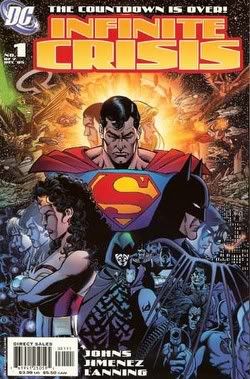Infinite Crisis is intended as a sequel and a celebration to a hugely popular and influential series published twenty years ago called Crisis on Infinite Earths. Up until the 1980s, DC titles didn't share a single universe. It consisted of several parallel universe, ("earth" is the used term of a parallel universe). Multiple iteration and interpretation of characters existed in the different earths. To avoid confusion, DC editors decided to mainstream their titles. They utilized the twelve issue maxiseries to accomplish this goal. At the end of the series, the different earths and characters are merged into one definitive version. The universe-spanning series was a huge success. That was in 1986.
 In 2006, just in time for the twenty year anniversary, Infinite Crisis continues the story of the original Crisis. The preparation and build up for the event was impressive. Various hints and plot points were subtly teased in various titles years before it was announced. The story practically affected every DC title, some more than others. A huge number of titles set up the conflict that were going to be. In addition, there were four concurrently running six-issue miniseries that prelude the main series. All the titles sold very well. Some issues were re-printed due to high demand. With the massive build up, Infinite Crisis managed to match the level of importance the original Crisis had.
In 2006, just in time for the twenty year anniversary, Infinite Crisis continues the story of the original Crisis. The preparation and build up for the event was impressive. Various hints and plot points were subtly teased in various titles years before it was announced. The story practically affected every DC title, some more than others. A huge number of titles set up the conflict that were going to be. In addition, there were four concurrently running six-issue miniseries that prelude the main series. All the titles sold very well. Some issues were re-printed due to high demand. With the massive build up, Infinite Crisis managed to match the level of importance the original Crisis had.Creatively, Infinite Crisis is well made, at least in the beginning. The series is written by Geoff Johns, a fan favorite and best selling writer, and (mostly) drawn by Phil Jimenez, another fan favorite and excellent artist. It started very well, or even fantastically if I might say. The story brings back a plot point from the original Crisis. A group of people that survived the original Crisis have taken the initiative to bring back their earth, one that was destroyed to make way for the current one. However, to bring this about, they may have to destroy this earth in the process. Another major plot running in the story is the philosophical conflict between the three most iconic characters in DC, Superman, Batman, and Wonder Woman. They no longer trust each other, leaving the other heroes in a state of disarray, unable to quell the crisis at hand.
The mechanics of the title are impressive. Each issue packs a considerable amount of story, making it a hectic read, but it illustrates the chaos that is going on in the story. In the action packed story, Johns still manages to write excellent characterization to the cast of thousand. Dozens of memorable moments and lines are scattered throughout the series. In the art department, Jimenez is able to portray the chaos and still make things clear for readers. That's easy to say, but in reality, next to impossible to do. Jimenez did great. The series was building to be a classic.
Unfortunately, Infinite Crisis started to falter halfway through. The first indicator was the art. As a monthly published series, Infinite Crisis packs a higher than average page count and even more details per page compared to a typical monthly comic book. Presumably DC has allocated a lead in time, so that Jimenez would have a leeway in producing the art. It still wasn't enough. Not wanting to delay the title, DC brought in other artists to help Jimenez beat the deadline. Some were good (including the legendary George Perez), some weren't as good, all weren't consistent to Jimenez's style. Reading a story where the illustration suddenly changes from page to page is infuriating. You wouldn't want it on a regular title. You definitely don't want it in something as big as Infinite Crisis. Even worse, the art actually gets worse and worse as it nears the end.
The strong writing soon followed the downward trend. The first few issues are a great read, setting up many conflicts in the story. But the seven issue format proves to be inadequate to accomodate the story. The dense issues don't let the reader to breathe and slow down; the pace is inhuman. With not enough space, the various conflicts resolution are barely adressed. Some are exported to regular titles. Readers that want to see how a conflict ended has to get other books. Some events that were touted as important (they had their own miniseries preluding Infinite Crisis) end up as nothing as a plot device. The conclusion of the series is the greatest sinner of all. All the conflict and drama peaked in issue six with the death of a character. By the time issue seven hits the stands, any sense of urgency and drama is gone making the series ultimately anti-climactic.
The criticisms might sound a little harsh. The series as a whole is still a very good read. But after all the build up for the last two years, I was expecting something more. A classic. The first few issues just worsened that anticipation with its brilliance. When the quality dropped with the last few issues, I can't help but to be disappointed.
No comments:
Post a Comment